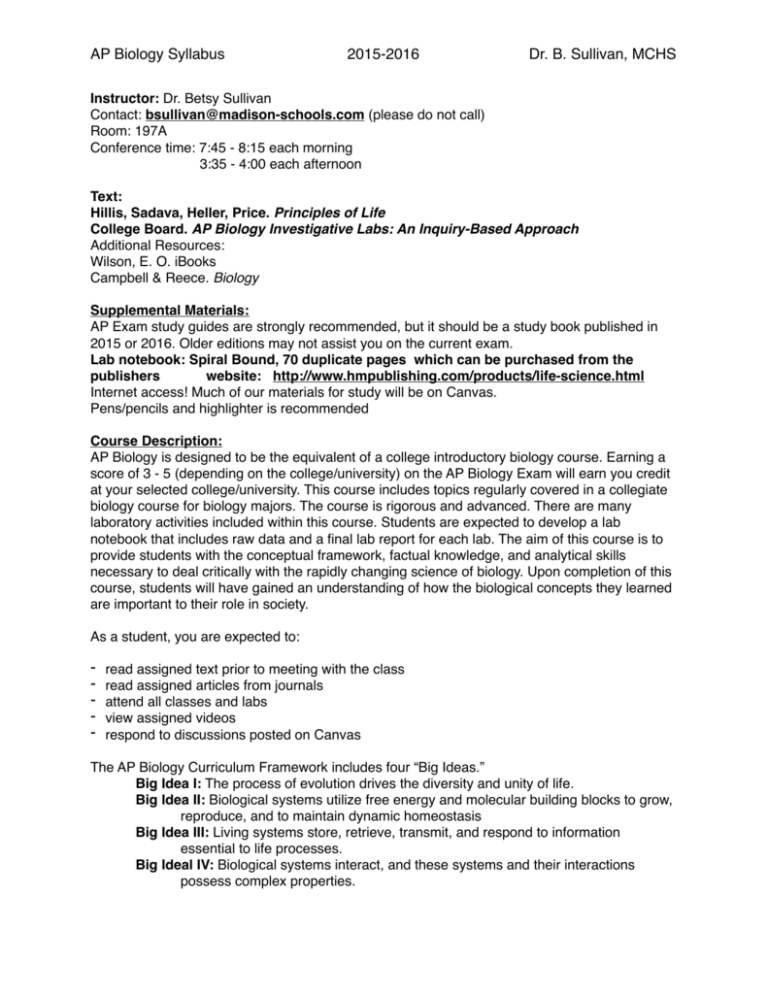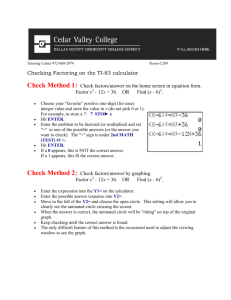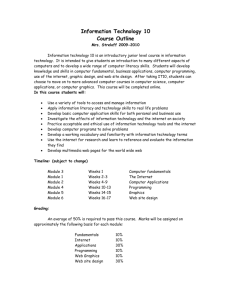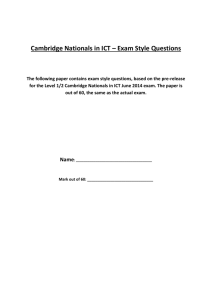AP Biology syllabus 2015-2016
advertisement

AP Biology Syllabus 2015-2016 Dr. B. Sullivan, MCHS Instructor: Dr. Betsy Sullivan! Contact: bsullivan@madison-schools.com (please do not call)! Room: 197A! Conference time: 7:45 - 8:15 each morning! ! ! 3:35 - 4:00 each afternoon! ! Text: ! Hillis, Sadava, Heller, Price. Principles of Life! College Board. AP Biology Investigative Labs: An Inquiry-Based Approach! Additional Resources:! Wilson, E. O. iBooks! Campbell & Reece. Biology! ! Supplemental Materials:! AP Exam study guides are strongly recommended, but it should be a study book published in 2015 or 2016. Older editions may not assist you on the current exam.! Lab notebook: Spiral Bound, 70 duplicate pages which can be purchased from the publishers website: http://www.hmpublishing.com/products/life-science.html ! Internet access! Much of our materials for study will be on Canvas. ! Pens/pencils and highlighter is recommended! ! Course Description:! AP Biology is designed to be the equivalent of a college introductory biology course. Earning a score of 3 - 5 (depending on the college/university) on the AP Biology Exam will earn you credit at your selected college/university. This course includes topics regularly covered in a collegiate biology course for biology majors. The course is rigorous and advanced. There are many laboratory activities included within this course. Students are expected to develop a lab notebook that includes raw data and a final lab report for each lab. The aim of this course is to provide students with the conceptual framework, factual knowledge, and analytical skills necessary to deal critically with the rapidly changing science of biology. Upon completion of this course, students will have gained an understanding of how the biological concepts they learned are important to their role in society.! ! As a student, you are expected to:! !- ! read assigned text prior to meeting with the class! read assigned articles from journals! attend all classes and labs! view assigned videos! respond to discussions posted on Canvas! The AP Biology Curriculum Framework includes four “Big Ideas.” ! ! Big Idea I: The process of evolution drives the diversity and unity of life.! ! Big Idea II: Biological systems utilize free energy and molecular building blocks to grow, ! ! ! reproduce, and to maintain dynamic homeostasis! ! Big Idea III: Living systems store, retrieve, transmit, and respond to information ! ! ! ! essential to life processes.! ! Big Ideal IV: Biological systems interact, and these systems and their interactions ! ! ! possess complex properties.! AP Biology Syllabus 2015-2016 Dr. B. Sullivan, MCHS ! The Investigative Laboratory Component! The laboratory component of this course is inquiry based. There are 13 AP biology lab activities. This class will conduct a minimal of 8 of those while preparing for all 13. Supplemental activities may be brought in to advance student understanding. The labs will often require more than 1 class period. Students are expected to read labs in advance to understand the skills required in each lab. The written labs are considered guided inquiry. Built into each of the labs is an open inquiry section in which students develop their own study based on the guided inquiry. You will conduct coupled inquiry. ! ! The following is from the NSTA News: ! “Coupled inquiry combines a guided-inquiry investigation with an open-inquiry investigation (Dunkhase, 2000). By beginning with an invitation to inquiry along with the guided inquiry, the teacher chooses the first question to investigate, specifically targeting a particular standard or benchmark (Martin, 2001). After the guided inquiry, a more student-centered approach is taken by implementing an open-inquiry investigation. This approach of guided inquiry followed by open inquiry results in student-generated questions that closely relate to the standard or benchmark from the first investigation. Specific concepts can be explored in a more didactic fashion allowing students to connect their concrete experiences to abstract concepts, similar to a learning-cycle approach. The coupled-inquiry cycle is as follows: 1) an invitation to inquiry, 2) teacher-initiated “guided inquiry,” 3) student-initiated “open inquiry,” 4) inquiry resolution, and 5) assessment. This cycle can then lead back to more student-initiated open inquiry (Dunkhase, 2000; Martin, 2001).” (http://www.nsta.org/publications/news/story.aspx?id=46515)! ! In addition to conducting coupled-inquiry investigations, students must be able to communicate the information gained from these inquiries through the use of:! - formal written lab reports, with emphasis on a testable hypothesis, organized collected data, and the ability to analyze and discuss results! - poster presentations to the class on the main components of the lab! - self-assessment group work using Canvas, allowing collaboration with peers! ! Grading Policy:! Major grades (unit tests, lab reports, major projects):! Minor grades (formative assessments)! ! ! ! 65%! 35%! Late Work Policy:! When absent, a student with an excused absence will have one day for every day absent in which to submit missed work. Students with an unexcused absence will not be able to submit work for credit.! ! If a student simply does not have an assignment, the student will receive an NG (factors as a 0) for the grade. This prepares the student for a college course, as professors do not accept late work. ! ! Honor System:! Students are expected to develop their own work. Students found copying any portion of another student’s assignment will receive a 0 as a grade. ! ! ! AP Biology Syllabus Day Chapter Pages 2015-2016 Dr. B. Sullivan, MCHS Topic(s) Assessments 1 1 1-14 Discussion: Organizing Themes of Biology! Discussion: Scientific Method Concept Mapping. ! Web Activity 1.2 and presentation of data/graphs! Questions from figs 1.9 & 1.10 2 1 10-14 Lab: Scientific Method/ Inquiry Lab Analysis! Animated Tutorial 1.1 3 2 16-21 Discussion: Chemical context of life! Lab: Acids/Bases/Buffers Ball & Stick modeling/Paper models! Animated Tutorial 2.1 4 2 21-22 Discussion: properties of water free response question 5 2 21-22 Mini lab: properties of water! Discussion: macromolecules Lab analysis! Web activity 2.1! Animated Tutorial 2.2! Web activity 2.2 6 2 23-29 Discussion: metabolism/ reactions! Lab: metabolism Ball & Stick modeling/Paper models! Animated Tutorial 2.1 7 3 29-39 Discussion: nucleic acids as macromolecules Lab analysis! Web activity 3.1 & 3.2 8 3 39-54 Discussion: structure and function Pipe cleaner proteins! of proteins Web activity 3.3! Animated Tutorial 3.1! Investigation Fig 3.10 9 3 49-54 Discussion: enzyme kinetics! Toothpickase Lab Web activity 3.4! Animated Tutorial 3.1! Investigation Fig 3.10 10 3 46-54 AP Lab 13: Enzyme Function Presentation of Data/graphics! Lab report in lab notebook 11 Unit Exam: Chemistry, Biochemistry, & Enzymes 12 4 57-76 Discussion: cell biology! Lab: Cell structure (microscope) Lab drawings/ Analysis 13 4-5 57-91 Cell function activity! Discussion: cell membrane structure and function Web activity 5.1! Interactive tutorial 5.1! Questions fig. 5.2 14 5 78-91 AP Lab 4: Diffusion & Osmosis Presentation of Data/graphics! Lab report in lab notebook 15 5 78-91 Lab: cell size & diffusion Free response questions & scoring 16 5 89 Lab: cell membrane model making Lab analysis! Discussion questions AP Biology Syllabus 17 5 91-99 18 2015-2016 Discussion: cell response! Case Study: cell signaling Dr. B. Sullivan, MCHS Working with Data 5.2! Animated tutorial 5.4 & 5.5! Analysis questions/diagrams Unit Exam: Cells 19 6 101-113 Discussion: ATP, chemiosmosis & Web activity 6.1 - 6.6! cell respiration Free response question & scoring 20 6 106-113 AP Lab 6: Cell Respiration Presentation of Data/graphics! Lab report in lab notebook 21 6 113-120 Discussion: Photosynthesis -light dependent & independent Animated tutorials 6.3-6.5! Web activity 6.6! Free response question & scoring 22 6 113-120 AP Lab 5: Photosynthesis! Review: photosynthesis Presentation of Data/graphics! Lab report in lab notebook 23 6 101-120 Test: Photosynthesis 24 7 127-132 Discussion: cell cycle! Set up: AP Lab 7 Web activity 7.1, 7.2, 7.3! Animated tutorial 7.1 25 7 AP Lab 7: Cell Division: Mitosis & Meiosis Presentation of Data/graphics! Lab report in lab notebook 26 7 132-142 Discussion: cell cycle controls! Discussion: meiosis vs mitosi Concept map! Web activity 7.4! Venn diagram 27 8 144-150 Discussion: Mendelian genetics! practice genetics problems Punnett squares! Web activity! genetics problems 28 8 150-151 Activity: probability ! Discussion: pedigree analysis Lab questions! Free response questions! Interactive tutorial 8.1 29 8 152-155 Discussion: beyond Mendelian genetics! Discussion: sex linkage genetics problems! animated tutorial 8.2! free response question 30 8 156-160 AP Lab 2: Mathematical Modeling Presentation of Data/graphics! Lab report in lab notebook 31 8 160-162 Discussion: prokaryotic gene exchange! DNA structure & function free response question! animated tutorial 9.1 32 9 171-185 Discussion: DNA replication & mutation! Activity: DNA replication! review animated tutorial 9.2 - 9.4! web activity 9.1! interactive tutorial 9.1! Activity summary/product AP Biology Syllabus 33 2015-2016 Dr. B. Sullivan, MCHS Unit Test: Genetics & Replication 34 10 188-204 Discussion: transcription & translation animated tutorial 10.3! working with data 10.1! web activity 10.1-10.2! interactive tutorial 10.1 35 10 188-206 Activity/review: protein synthesis! Discussion: post-translation control Activity summary/product! written response! animated tutorial 10.4 36 11 208-225 Discussion: Viral, prokaryotic & eukaryotic gene expression web activity 11.1 - 11.2! animated tutorials 11.1 - 11.3! Free response question 37 11 AP Lab 8: Biotechnology Bacterial Transformation Presentation of Data/graphics! Lab report in lab notebook 39 13 208-225 Gene Expression lab activities! (C. elegans) Lab questions! 40 13 244-262 Discussion: Restriction enzymes & recombinant DNA and cloning animated tutorial with data 13.1 ! web interactive 13.1 41 13 244-262 42 Discussion: recombinant DNA! AP Lab 9: Biotechnology restriction enzyme Presentation of Data/graphics! Lab report in lab notebook 43 Test: Protein Synthesis & Biotechnology 38 44 14 263-292 Discussion: genes, development evolution, & theory of evolution animated tutorial 14.1 - 14.4, 15.1! web activity 14.2! interactive tutorial 14.1 45 15 292-300 Discussion: population genetics! Discussion: natural selection Web activity 15.1! 46 15 300-313 Lab: Natural Selection ! http://www.biologyinmotion.com/ evol/index.html Activity summary/product! written response! animated tutorial 10.4 47 16 316-331 Discussion: phylogeny! Activity: cladogram/phylogenetic tree web activity 16.1 - 16.2! Cladogram construction 48 16 AP Lab 1: Artificial Selection Ongoing lab 49 17 333-346 Discussion: modes of speciation! Activity: speciation interactive tutorial 17.1! animated tutorial 17/1 - 17.2! working with data 17.1! activity questions 50 18 347-348 Discussion: 5 major extinctions! Test: Evolution AP Biology Syllabus 2015-2016 Discussion: lines of common descent! Discussion/activity: Endosymbiosis Dr. B. Sullivan, MCHS 51 19-20 366-392 52 21 411-426 Discussion/Lab: plant adaptations! Lab questions! Lab: plants and seeds Free response questions! Interactive tutorial 8.1 53 12 426-436 Lab: flowers, fruits, & reproduction web activity 21.5! animated tutorial 21.3-23.3! working with data 23.1 54 23 490-503 Discussion: animal body plans & vertebrate diversification on land! Activity: transmission to land web activity 23.4! Amniotic Egg Analysis! Activity questions 55 24 504-520 Discussion & Lab: Plant structure and function Web activities 24.1-24.5! labeling activity! lab analysis 56 25 521-538 AP Lab 11: Transpiration Presentation of Data/graphics! Lab report in lab notebook Discussion: plant growth, development, & reproduction web activities 26.1, 26.3, ! animated tutorial 26.1, 26.2 Discussion: cell signaling in plants and the environment! Activity: plant cell signaling animated tutorial 27.1-27.2, 28.1! Working with data 28.1! Discussion: temperature regulation, homeostasis, and hormones as chemical messengers Web activities: 29.1 - 29.2, 30.1-30.2! working with data 29.1! animated tutorial 29.1, 30.1-30.3 57 animated tutorial 19.1 - 20.1! video 58 26-27 539-568 59 28 573-586 60 29-30 589-619 61 30 604-619 Lab/activity: hormones Lab questions! 62 31 621-637 Discussion: immune response! Activitiy: immune system animated tutorials 31.1-31.4! web activities 31.3-31.2! activity questions 63 32-33 638-668 Discussion: human reproduction & gastrulation animated tutorials 32.1-32.2, 33.1-33.2! web activities 32.1 - 32.2 64 Test: Adaptations and Phylogeny 65 34 673-684 Discussion: electrical transmission in neurons and chemical transmission in neurons animated tutorials 34.1-34.4! web activities 34.1-34.2! interactive tutorials 34.1-34.3 66 34 684-690 Activity/lab: nervous system summary questions AP Biology Syllabus 67 35 696-704 68 2015-2016 Dr. B. Sullivan, MCHS Discussion: sensory systems! Lab senses interactive tutorial35.1! web activity 35.1! animated tutorial 35.1! lab questions/analysis 37-38 732-764 Discussion: respiratory & circulatory system animated tutorial 37.1, 38.1! working with data 37.1! web activity 38.1-38.3! interactive tutorial 38.1 69 39-40 766-798 Discussion: digestion & excretion web activities 39.1 - 39.3, 40.1-40.4! animated tutorials 39.1-39.2, 40.1! interactive tutorial 39.1 - 40.1! body map/poster 70 39-41 673-819 Discussion: human systems & social behaviors animated tutorials 41.1-41.4! interactive tutorial 41.1! web activities 41.1-41.2 71 41 814-819 AP Lab 12: Animal Behavior Presentation of Data/graphics! Lab report in lab notebook 72 41 804-823 Discussion: development of social behavior! Discussion: organisms & their environments animated tutorial 42.2! web activity 42.1! group collaboration & presentation 73 43 843-858 Discussion: population ecology web activity 43.1! animated tutorials 43.1-43.4! Working with data 43.1 74 44 860-872 Discussion: ecology & evolution animated tutorial 44.1! web activity 44.1 75 45 873-891 Discussion: community ecology animated tutorials 45.1-45.3! web activities 45.1-45.2! working with data 45.1 AP Lab 10: energy dynamics Presentation of Data/graphics! Lab report in lab notebook Discussion: biogeochemical cycles & climate change animated tutorials 46.1-46.4! web activities 46.1-46.2 76 77 45-46 46 896-907 78 Test: Ecology & Behavior 79 Review: AP Biology Exam 80 81 Submit lab notebooks 82 83 AP Biology Syllabus 2015-2016 Dr. B. Sullivan, MCHS ! ! Course and Classroom Expectation! There is a lot of out of classroom reading that will be necessary for students to be successful in this course. There will be quizzes on both previous content and reading assignments. Your attendance is critical to your success in this course.! ! All work including notes from class must be kept in an organized manner. I encourage you to use the MacBook Air, organizing your content into folders. Be sure to add the calendar app to your dock and keep your assignment due dates posted within your calendar. ! ! You are expected to work cooperatively with the teacher and your peers when in class. A respectful manner for all will make this a conducive class. ! Arrive on time and be prepared in class. Begin the Do Now activity immediately upon arrival. It is not a visitation time. ! ! I enforce the cell phone rule (have it out only when I say to have it out - if you are caught with the phone out, I will take it up.) ! ! I enforce the district dress code.! ! I adhere to an honor system. However, if you do not follow the honor system, you will be given a 0 for the work.! ! I prefer email contact. Students must use their school issued email account to contact me. Parents may contact me directly.! ! ! ! ! ! ! ! ! ! ! ! ! ! ! ! ! ! ! ! ! ! ! ! AP Biology Syllabus ! ! ! ! ! ! ! ! ! ! ! ! ! ! 2015-2016 Dr. B. Sullivan, MCHS Syllabus Agreement! ! I, _________________________________________________________ (print student name), agree to the guidelines explained within the syllabus and will work diligently to uphold the standards at MCHS.! ! I, _________________________________________________________ (print parent name), have reviewed the syllabus with my child and will support my student in his/her efforts to uphold the standards at MCHS.! ! ! ___________________________________________ (Student signature)! ! ! ! ! ! ____________________________! (Date)! ___________________________________________ (Parent signature)! ! ! ! ! ! ____________________________! (Date) !





